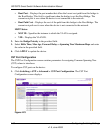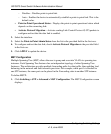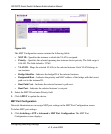
GS700TS Smart Switch Software Administration Manual
Configuring Switching Settings 4-38
v1.0, June 2009
– Designated – Indicates the port or LAG through which the designated switch is
attached to the LAN.
– Alternate – Provides an alternate path to the root switch from the root interface.
–Backup – Provides a backup path to the designated port path toward the Spanning
Tree leaves. Backup ports occur only when two ports are connected in a loop by a
point-to-point link, or when a LAN has two or more connections connected to a shared
segment.
– Disabled – Indicates the port is not participating in the Spanning Tree.
• Mode – Displays the current STP mode. The STP mode is selected in the STP
Configuration screen. The possible field values are:
– STP – Indicates Classic STP is enabled on the device.
– RSTP – Indicates Rapid STP is enabled on the device.
• Fast Link Operational Status – Displays the Fast Link status for the interface. If Fast
Link is enabled for a port, the port is automatically placed in the forwarding state. The
possible field values are:
– Enabled – Indicates Fast Link is enabled on the interface.
– Disabled – Indicates Fast Link is disabled on the interface.
• Status – Displays the RSTP status for the interface. The possible field values are:
– Enabled – Indicates RSTP is enabled on the interface.
– Disable – Indicates RSTP is disabled on the interface. This is the default value.
• Point-to-Point Admin Status – Select whether a point-to-point link is established. Ports
defined as Full Duplex are considered Point-to-Point port links. The possible field values
are:
– Enable – Enables a point-to-point link, or configure to automatically establish a point-
to-point link. To establish communications over a point-to-point link, the originating
PPP first sends Link Control Protocol (LCP) packets to configure and test the data
link. After a link is established and optional facilities are negotiated as needed by the
LCP, the originating PPP sends Network Control Protocol (NCP) packets to select and
configure one or more network layer protocols. When each of the chosen network
layer protocols has been configured, packets from each network layer protocol can be
sent over the link. The link remains configured for communications until explicit LCP
or NCP packets close the link, or until some external event occurs. This is the actual
switch port link type. It may differ from the administrative state.


















